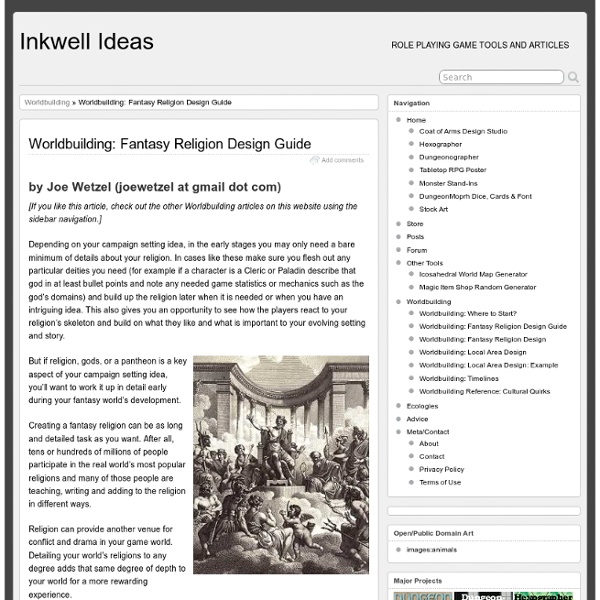religion in fantasy novels | helluo librorum
Since no one burned my house down after the Tolkien post, I’m going out on a limb here and talk to you about using religion in your fantasy novels. Generally speaking, when building worlds in fantasy novels, the religions of your world will be a reflection of the religions here on good old planet earth. So I’m going to offer a few suggestions – take them or leave them: Know thy religion. Understand the core beliefs. Avoid stereotypes. Religions don’t kill. Treat all religions with respect. Don’t be malicious. World building is a difficult process; as a fantasy writer you are creating a whole social order, and you want it to be believable. A few articles to see: If you’re looking for a checklist of questions to ask when world building, go to the SFWA blog where Fantasy Worldbuilding Questions by Patricia C. Joe Wetzel at Inkwell Ideas has a great article with Worldbuilding: Fantasy Religion Design Guide, and a subsequent post, Worldbuilding: Fantasy Religion Design Example. Like this:
Sacred Text Archive
Hebrew Goddess; Asherah, the Shekinah, consort of Yahweh
The Hebrew Goddess Painting by Jonathon Earl Bowser Asherah, known as the "Lady of the Sea" Asherah, the Shekinah, consort and beloved of Yahweh. God-the-Mother. n hill-tops, such as Zion, Mount of Olives, Har Megiddo and countless others. Here is an excerpt from one of our Mystery School lessons: Exercise 5: (Extra Credit) If you're really brave, not worried about being called a "heretic Jezebel," try making some Asherah cakes. *A word about snakes: The Serpent, though a frightening symbol because of its ability to bring death, stood also for ancient wisdom and immortality. ideas. Asherah from the Religion of the Canaanites She was the wife of El in Ugaritic mythology, and is the goddess who is also called Athirau-Yammi: "She Who Walks on (or in) the Sea." Asherah, like Anat, is a well-documented goddess of the northwest Semitic pantheon. If you are researching Her, searching for Her in the Bible, in the Torah, in Kabbala, there is one book you gotta read...
Daily Hávamál | Huginn's Heathen Hof | Page 16
Original-Ósnjallr maðrhyggsk munu ey lifaef hann við víg varasken elli gefrhonum engi friðþótt honum geirar gefi Translation-The cowardly manthinks he will live foreverif he just avoids conflictbut old age gives him no peacethough spears have spared him-Hávamál: Stanza 16 Much like the preceding stanza (15), this verse gives us a glimpse into ancient Germanic philosophy. In fifteen, Odin told us that we should be both cheerful and generous until death finds us. Original-Kópir afglapier til kynnis kømrþylsk hann umbeða þrumiralt er sennef hann sylg um getruppi er þá geð guma Translation-The foolish man stareshovering about the edges of the feastHe mumbles to himself,or just sits silently.But once he has a few drinks,everybody will know what a fool he is. Today’s stanza needs little explanation. Original-Þagalt ok hugaltskyli þjóðans barnok vígdjarft veraglaðr ok reifrskyli gumna hverrunz sínn bíðr bana This stanza shifts us from “advice about life”, to “advice about how to live”.
Asatru Folk Assembly - Home
Asatru Update
Aztec Calendar
Internet Sacred Text Archive Home
Ancient Days :: Who Were the Sons of God in Genesis 6? :: by David Livingston
In Genesis 6:1-8 we read about some persons who may be a pre-Flood link between the Bible and the cultures of the ancient Near East. They are the "sons of the gods." The biblical reference to them should have some relationship with historical fact. Suggested Meanings for the "sons of god" Who actually were the "sons of god?" Another interpretation is that they were the sons of Seth, the godly line. The third possibility is that of rabbinical Jewish interpretation. Perhaps a combination of the first and third is the best explanation. A New Interpretation A new interpretation has been suggested by Meredith Kline (in The Westminster Theological Journal, May 1962). The fact that an historical theme so prominently treated in the Sumero-Babylonian epic tradition finds no counterpart (or connection with) Genesis 3-6 according to standard (traditional) interpretations is itself good reason to suspect that these interpretations have been missing the point (p. 199). Divine Kingship What is it? 1.
Ancient Days:: Comparison of Genesis with Creation Stories of the Ancient Near East :: by David Livingston
One Viewpoint Many professors in colleges, universities and seminaries today agree with the following ideas and teach them to their students. This is one reason young people who have had a strong religious faith lose it when they go to college. For many centuries, Jewish and Christian theologians agreed that the accounts of the world's origin given in Genesis were not only inspired by God, but owed nothing to any other scriptures. These authors are probably correct that all but Bible believers (fundamentalists) have abandoned this view. The Genesis Creation Story does not owe anything to the creation myths of Egypt and Mesopotamia. The first account of Creation (Genesis 1:1-2:31) was composed at Jerusalem soon after the return from the Babylonian Exile (500 BC). This interpretation of Genesis 1 and 2 agrees with many scholars. Out of these sources (Genesis through Numbers) they formed what is called the "Priestly History." Religion has evolved. Another Viewpoint Memphite Theology A.R. I.
Jewish angelic hierarchy
Angels in Judaism (angel: Hebrew: מַלְאָךְ mal’āḵ, plural mal’āḵīm) appear throughout the Hebrew Bible, Talmud, Rabbinic literature, and traditional Jewish liturgy. They are categorized in different hierarchies. Maimonides[edit] Maimonides, in his Mishneh Torah or Yad ha-Chazakah: Yesodei ha-Torah, counts ten ranks of angels in the Jewish angelic hierarchy, beginning from the highest: Kabbalah[edit] According to the Golden Dawn's interpretation of the Kabbalah, there are ten archangels, each commanding one of the choirs of angels and corresponding to one of the Sephirot. See also[edit] Hermetic Order of the Golden Dawn References[edit] External links[edit]



